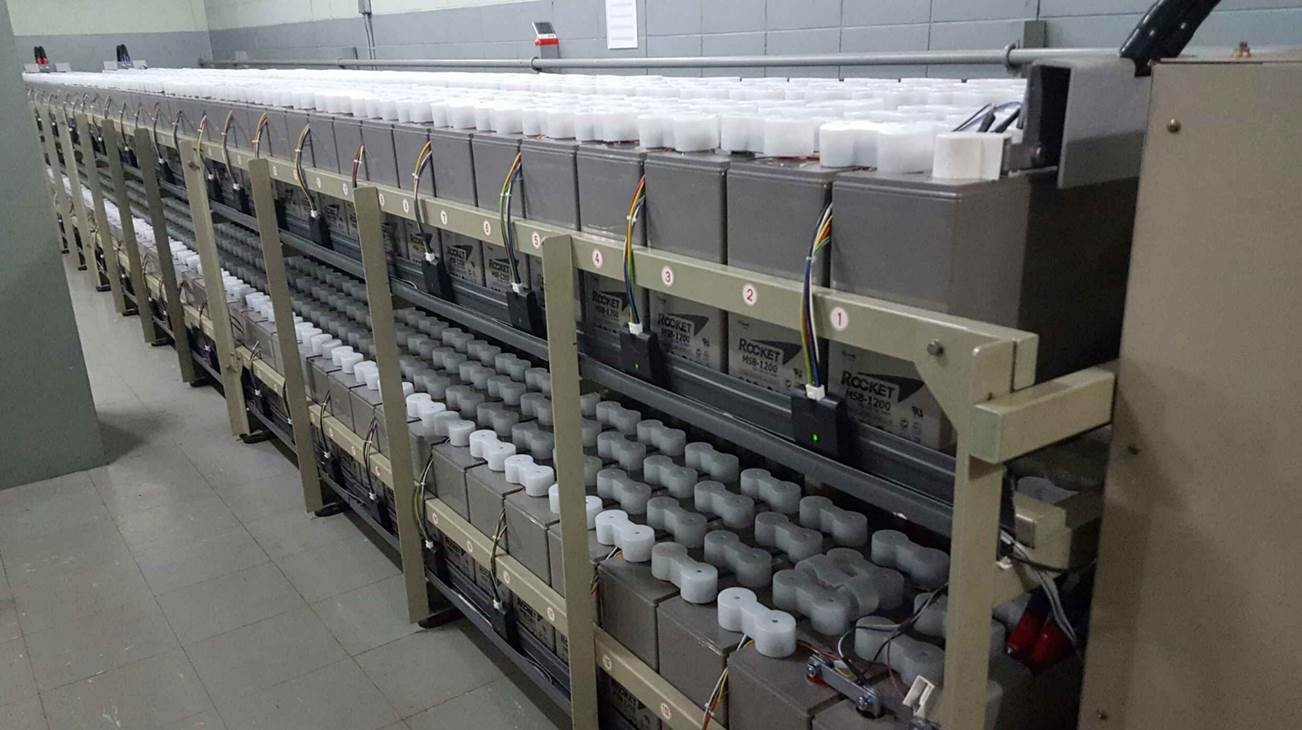Share this
Speaking the language of batteries
by PowerShield on Jun 18, 2018 11:03:54 AM
This is the sixth in a series of units that will educate the reader on the part played by a battery in an uninterruptible power system (UPS). Following are definitions of terms that are used throughout this collection of technical papers. Where noted, the definitions are standardized within the battery industry by IEEE Std. 1881.[1]
General formulae
Ohm’s Law is not unique to batteries, but its formula and terms must be understood to use batteries:
E = IR
voltage equals current times resistance
Voltage: Electromotive force (E) or potential difference, expressed in “volts” (V)
Current: The rate at which the flow of an electric charge passes through a conductor or through electrolyte, expressed in “Amperes” (A). [Note: The “I” in Ohm’s Law comes from the original French term for current intensity]
Resistance: A quantity that measures how the device or material reduces the electric current flow through it, expressed in Ohms (W).
Power: Units of energy divided by time; the rate at which electrical energy is transferred through an electric circuit, expressed in Watts (W). It is derived from Ohm’s law:
P = IE
Power equals current times voltage
Also expressed as joules per second
Definitions
The following definitions are listed in alphabetical order for easy reference (not by order of importance):
admittance The reciprocal of impedance, expressed in siemens (S), or sometimes as mho (℧). See also: internal ohmic measurement
aging factor The factor included during battery sizing to compensate for the end-of-life capacity loss[1]
ampere-hour capacity (or rating) The capacity assigned to a cell by its manufacturer for a given constant-current discharge, at a specified electrolyte temperature, to a given end-of-discharge voltage, for a specified duration[1]
arc flash hazard A dangerous condition associated with the possible release of energy caused by an electric arc[2] An arc flash (sometimes called flashover), is the light and heat produced as part of an arc fault, a type of electrical explosion or discharge that results from a low-impedance connection through air to ground or another voltage phase in an electrical system. An arc flash might also be accompanied by an arc blast, which is the supersonic shockwave produced when the uncontrolled arc vaporizes the metal conductors.
battery One or more cells connected electrically in series or parallel, or both, to provide the required operating voltage and current levels.[1] As discussed in Unit 2, large UPS batteries typically consist of hundreds of cells
battery life A measure of battery performance and longevity, which can be quantified in several ways: as run time on a full charge (service life), as estimated by a manufacturer in ampere hours (design life) , or as the number of cycles until the end of useful service (cycle life).
battery monitoring system A permanently installed system for measuring, storing and reporting battery operating parameters. [1]
battery cabinet A structure used to support and enclose a group of cells. [1] A battery cabinet can be installed in the same room as the UPS and/or IT equipment; it is usually locked to prevent access by unauthorized personnel.
battery rack An open structure used to support a group of cells or multi-cell units. [1]
battery room A portion of a building or facility with controlled walk-in access, physically set off from the rest of the building by walls, the primary purpose of which is to house a stationary battery or batteries.
bulk charge The period from the initiation of charging to the onset of gassing, during which charge is retuned to a battery at high efficiency. [1]
catalyst An agent introduced into the headspace of a VRLA cell to mitigate the effect of self-discharge of the negative electrode, thereby reducing dry out and extending the life of the cell.
cell The basic electrochemical building block of a battery, characterized by a positive electrode, a negative electrode, and electrolyte, encased in a container.[1] A cell can be a stand-alone unit (typically two volts nominal) or a multi-cell unit (typically six or twelve volts nominal).
charge The conversion of electrical energy into chemical energy within a secondary cell. [1]
conductance The ability of a battery to conduct current (see internal ohmic measurement)
cycle life (See battery life)
design life (See battery life)
electrolyte The aqueous or non-aqueous medium that provides the ion-transport mechanism between the positive and negative electrodes of a cell. [1] In a lead-acid cell, the electrolyte is a solution of water and sulfuric acid, the concentration of which is known as specific gravity.
equalizing charge A charge, at a level higher than the normal float voltage, applied for a limited period of time, to correct inequalities of voltage, specific gravity, or state of charge that may have developed between the cells during service. [1]
float charge A constant-voltage charge applied to a battery to maintain it in a fully charged condition, while minimizing degradation or water consumption [1]
flooded A slang term used to identify a vented cell or battery, in which the electrodes are immersed in free-flowing liquid electrolyte.
freshening charge A charge given to a battery following its nonuse or storage in order to return it to a near maximum state of charge and to mitigate the effects of self-discharge [1]
high rate cell A cell designed to supply a duty cycle requiring a high current for a short period of time, i.e., less than one hour[1]. Almost all data center UPS batteries use high rate cells.
half life As applied to battery operating temperature, the sustained temperature at which the expected service life of a battery is reduced by 50%.
immobilized electrolyte Liquid electrolyte in a cell that is prevented from free flowing by use of either gelled electrolyte or absorbed glass mat technology [1] .
impedance A measure of the opposition to an alternating current; a combination of internal resistance and reactance. [See also: internal ohmic measurement]
intercell connector An electrically conductive bar or cable used to connect adjacent cells in a battery[1].
intermittent charge A non-continuous charging regime based on the following: (1) availability of the charging source; or (2) application of the charge by a permanently powered source [1].
internal ohmic measurement A measurement of the electronic and ionic conduction paths within a cell or unit, expressed in terms of conductance, impedance, resistance, or admittance[1].
internal resistance The resistance within a cell or battery that causes a drop in the source voltage when there is a current. (See internal ohmic measurement)
lead-acid cell A secondary cell in which the active material of the positive electrode is lead dioxide, the active material of the negative electrode is lead, and the electrolyte is dilute sulfuric acid[1]
multicell unit Multiple cells in a single container
nominal battery voltage The value assigned to a battery of a given voltage class for the purpose of convenient designation. The operating voltage of the system may vary above or below this value [1].
nickel-cadmium (Ni-Cd) cell. A secondary cell in which the active material of the positive electrode is nickel oxyhydroxide, the active material of the negative electrode is cadmium, and the electrolyte is a dilute solution of potassium hydroxide [1].
ohmic value (See internal ohmic measurement)
rack An open structure, typically in a battery room, used to support a group of cells/units.
parallel strings The interconnection of two or more strings in which the like terminals of each battery string are connected together to increase the available power without changing voltage.
personal protective equipment (PPE) Protective clothing, helmets, goggles, or other garments or equipment designed to protect the wearer's body from injury or electric shock. Hazards addressed by battery PPE equipment can include physical, electrical, heat, chemicals, and airborne particulate matter, but not all at the same time.
performance test A constant-current or constant-power discharge capacity test, made on a battery after being in service.
preventive maintenance Maintenance that is regularly performed on a battery to lessen the likelihood of it failing, usually performed while the battery is connected.
post corrosion The formation of compounds on a post that can affect connection quality, and in extreme cases can result in failure of a post or post-to-cover seal and cracking of a cover or container[1].
pulsed charging Variation of intermittent charging in which the charger switches on and off several times per minute (or per second).
rated capacity The capacity assigned to a cell by its manufacturer for a given discharge rate, at a specified electrolyte temperature, to a given end-of-discharge voltage [1].
recombination A feature of VRLA cells in which oxygen generated at the positive plates is ultimately recombined with hydrogen ions at the negative plates and converted back into water. In this process, hydrogen gas formation and evolution are suppressed.
ripple A periodic waveform riding in the dc circuit, normally expressed as peak-to-peak, or root mean square (rms). Can refer to voltage or current[1].
sealed cell A cell that is designed not to allow release of gas or electrolyte during normal operation.
safety data sheet (SDS) A hazard communication form (also known as a Material Safety Data Sheet [MSDS]), by which regulators require a battery manufacturer, importer, distributor, or integrator to identify each hazardous material present in a battery unit; typically readily accessible to anybody expected to perform maintenance on a battery system[3].
Sealed lead-acid (SLA) Another term for a valve-regulated lead-acid cell, derived from the characteristic of VRLA in which electrolyte can be neither added nor removed under conditions of normal operation; also considers that the safety pressure valve is closed to prevent escape of gas under conditions of normal operation.
secondary cell An electrochemical cell that is capable of being recharged following discharge[1].
service life (See battery life) The period of useful operation under specified conditions.
specific gravity The ratio of the mass of a given volume of electrolyte to the mass of an equal volume of water at a specified temperature. Specific gravity options are often available for vented lead-acid batteries; the specific gravity of VRLA batteries is usually fixed[1].
state of charge (SOC) The stored or remaining capacity in a battery expressed as a percentage of its fully-charged capacity[1].
state of health (SOH) A measure representing the present state of battery available capacity or remaining service life relative to rated capacity or specifications[1]. (See battery life).
stationary battery A battery designed for service in a permanent location[1].
string A grouping of interconnected cells that has the same nominal voltage as the dc system[1].
A UPS battery might have a single string or parallel strings.
temperature compensation The adjustment of charging voltage with respect to temperature, normally accomplished using a slope or step function, to prevent thermal runaway[1].
thermal runaway A condition that is caused by a battery charging current or other process, which produces more internal heat than the battery can dissipate[1], potentially leading to fire in a short amount of time.
thermal walkaway (See thermal runaway) A variation of thermal runaway that occurs over a longer period of time and usually results in battery failure but not necessarily fire.
unit A single container. This term is usually preceded by “single-cell” or “multi-cell”.
vented lead-acid (VLA) cell A lead-acid cell in which the products of electrolysis and evaporation are allowed to escape to the atmosphere as they are created, also referred to as a “flooded cell”[1].
valve-regulated lead-acid (VRLA) cell A lead-acid cell that is sealed with the exception of a valve that opens to the atmosphere when the internal pressure in the cell exceeds atmospheric pressure by a preselected amount. VRLA cells provide a means for recombination of internally generated oxygen and the suppression of hydrogen gas evolution to limit water consumption[1].
References
[1] IEEE Std 1881TM, the IEEE Standard Glossary of Stationary Battery Terminology. Institute of Electrical and Electronics Engineers, 3 Park Avenue, New York, NY 10016-5997 (U.S.A.), www.ieee.org OR https://ieeexplore.ieee.org/document/7552407/definitions?anchor=definitions
[2] NFPA 70E,Ò Standard for Electrical Safety in the Workplace, National Fire Protection Association, 1 Batterymarch Park, Qincy, MA 02169-7471, (U.S.A.). See also: http://www.arcflashpro.com/arc-flash/nfpa-70e-definitions
[3] United Nations Economic Commission for Europe (UNECE), Globally Harmonized System of Classification and Labelling of Chemicals (GHS), (Unit 6)
Share this
You May Also Like
These Related Stories

Battery configurations in data centers

Battery charging regimes

All things big and small
- September 2024 (1)
- December 2021 (2)
- March 2020 (1)
- January 2020 (1)
- December 2019 (1)
- October 2019 (2)
- July 2019 (1)
- May 2019 (2)
- April 2019 (1)
- March 2019 (2)
- January 2019 (1)
- December 2018 (1)
- November 2018 (1)
- August 2018 (3)
- July 2018 (1)
- June 2018 (2)
- May 2018 (2)
- March 2018 (2)
- February 2018 (2)
- January 2018 (1)
- November 2017 (1)
- October 2017 (1)
- August 2017 (3)
- June 2017 (1)
- March 2017 (1)
- November 2016 (1)
- October 2016 (1)
- September 2016 (2)
